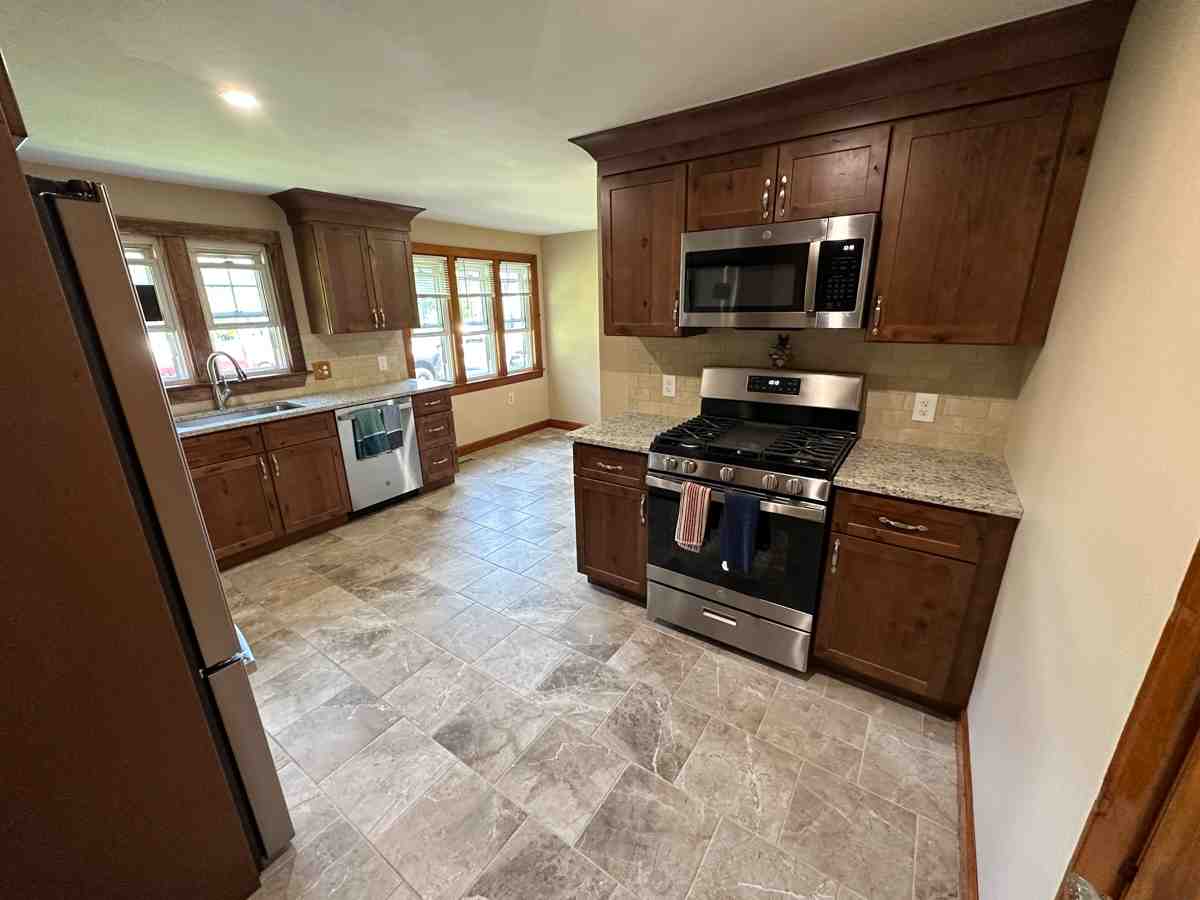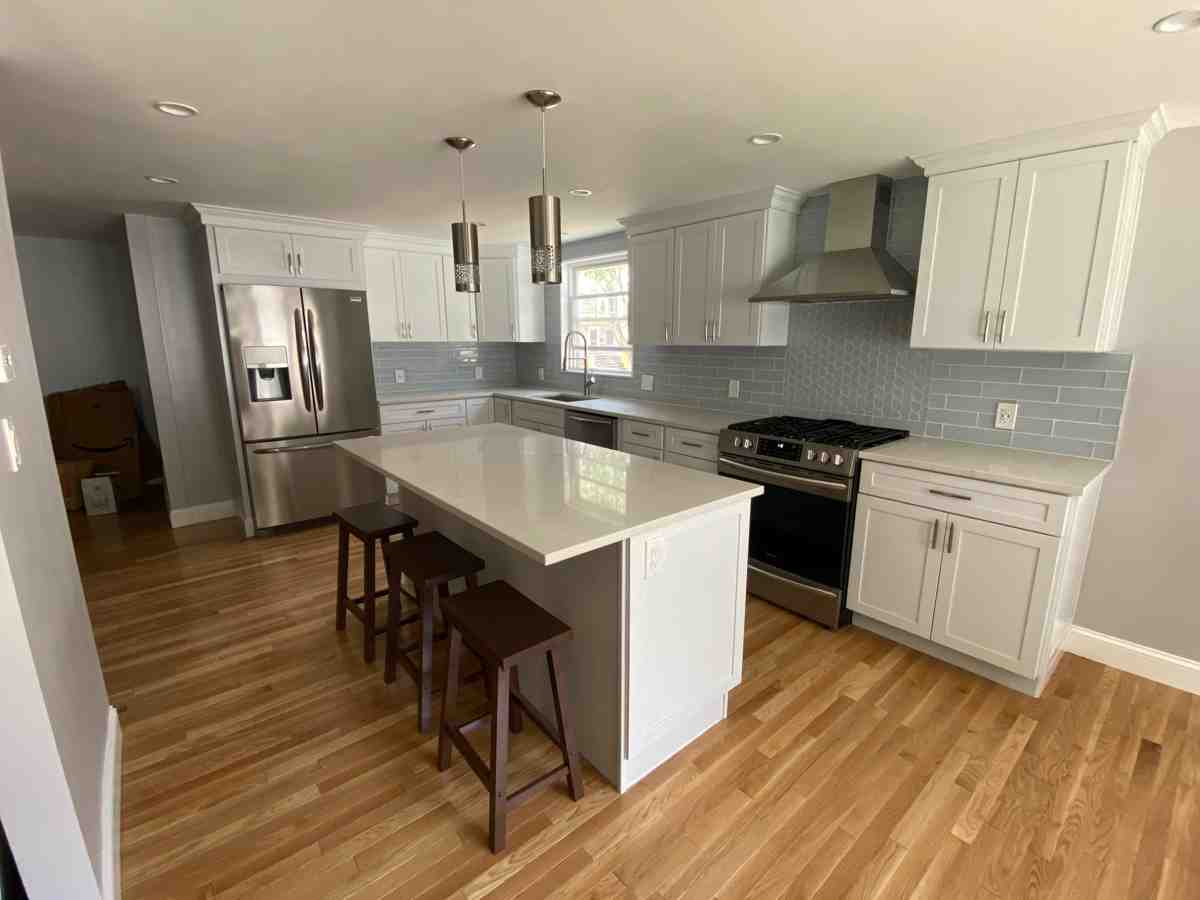How to Design a Kitchen Renovation: Top 10 Amazing Tips
Designing Your Dream Kitchen: A Comprehensive How-To Guide
How to design a kitchen renovation involves a few vital steps to ensure your dream kitchen combines both style and functionality.
Quick Start Guide:
– Assess needs: Evaluate what you love and what bothers you in your current kitchen.
– Plan layout: Think of the “work triangle” (sink, stove, fridge).
– Choose style: Decide on contemporary or traditional cabinetry.
– Pick appliances: Ensure they fit your needs and space.
– Budget: Set a realistic budget and stick to it.
A well-planned kitchen remodel can significantly improve your home’s functionality, efficiency, and aesthetic appeal. Not only does a functional kitchen make daily cooking more enjoyable, but it also adds value to your home.
I’m Tyler Tranni, owner and operator at Tranni Home Remodeling. With years of hands-on experience in changing kitchens in Billerica, MA, I have honed my expertise in how to design a kitchen renovation that meets both practical needs and style preferences.

Create a Plan
A successful kitchen renovation starts with a solid plan. Here’s how to get started:
Assess Your Current Kitchen
First, evaluate your existing kitchen. Identify what works well and what doesn’t. This assessment helps pinpoint strengths, weaknesses, and pain points.
Strengths:
– Ample natural light
– Efficient layout
– Quality flooring
Weaknesses:
– Limited storage
– Outdated appliances
– Poor workflow
Pain Points:
– Lack of counter space
– Inadequate lighting
– Hard-to-reach cabinets
Define Your Remodeling Goals
Next, outline your objectives. Are you looking to increase storage, improve workflow, update aesthetics, or all of the above? Prioritize your goals to guide your decisions.
Storage: If your kitchen feels cluttered, consider adding more cabinets or a pantry.
Workflow: Think about the “work triangle” – the ideal distance between the sink, stove, and refrigerator.
Aesthetics: Decide on a style that suits your taste, whether it’s modern, traditional, or something in between.
Create a Realistic Budget
Budgeting is crucial. According to Angi, a kitchen remodel costs $26,934 on average. However, prices can range from $14,600 for minor updates to $41,485 for larger projects.
Average Costs Breakdown:
– Cabinetry: 30-35%
– Labor: 20-25%
– Appliances: 15-20%
– Countertops: 10-15%
– Flooring: 5-10%
– Lighting: 5-10%
– Plumbing: 5-10%
Unexpected Expenses: Set aside 20% of your budget for surprises. This buffer helps avoid financial stress if issues arise.
Detailed Categories: Break down your budget into specific categories. This approach helps track expenses and ensures you’re not overspending in one area.
Example Budget Breakdown:
| Category | Budget Allocation |
|—————-|——————-|
| Cabinetry | $8,100 |
| Labor | $6,700 |
| Appliances | $4,000 |
| Countertops | $3,000 |
| Flooring | $2,000 |
| Lighting | $1,500 |
| Plumbing | $1,500 |
| Contingency | $5,000 |
Pro Tip: Order appliances months in advance and plan your project timeline around their delivery.
By assessing your current kitchen, setting clear goals, and creating a realistic budget, you lay the foundation for a successful kitchen renovation. Next, we’ll dive into choosing the perfect layout for your new kitchen.
How to Design a Kitchen Renovation
Designing your dream kitchen involves careful planning to ensure it’s both functional and stylish. Let’s dive into two key aspects: choosing the right layout and essential design tips.
Choose the Right Kitchen Layout
The layout is the foundation of your kitchen’s functionality. Here are the most popular kitchen layouts to consider:
U-Shape Layout
- Pros: Offers plenty of counter space and storage.
- Cons: May not fit an island, especially in smaller kitchens.
- Ideal For: Larger kitchens with multiple cooks.
L-Shape Layout
- Pros: Flexible and efficient, works well in small to medium-sized kitchens. Can accommodate an island.
- Cons: Might lack enough counter space in smaller kitchens.
- Ideal For: Open floor plans and maximizing corner space.
Galley Layout
- Pros: Efficient use of space, ideal for small kitchens.
- Cons: Can feel cramped and may limit storage.
- Ideal For: Compact spaces where every inch counts.
Island Layout
- Pros: Great for socializing, adds extra storage and workspace.
- Cons: Requires more space, can be expensive.
- Ideal For: Large kitchens and open-concept homes.
Pro Tip: Think about how you move around your kitchen when cooking. The “work triangle” – the ideal distance between the sink, stove, and refrigerator – is key to a well-functioning kitchen.
Design Tips for a Kitchen Remodel
Once you’ve chosen a layout, focus on these design tips to improve functionality and style:
Storage Near Dishwasher
- Tip: Place cabinets and drawers for dishes and utensils close to the dishwasher. This makes unloading faster and easier.
Trash Near Sink
- Tip: Position your trash and recycling bins near the sink. This setup simplifies cleanup and keeps your kitchen tidy.
Prep Space
- Tip: Ensure you have ample counter space for meal prep. Ideally, this should be between the sink and stove.
Pantry Storage
- Tip: Incorporate a pantry or additional storage solutions to keep your kitchen organized and clutter-free.
Work Space
- Tip: Designate specific zones for different tasks, such as cooking, baking, and cleaning. This helps streamline workflow and reduces clutter.
Pro Tip: Break up the surface of your island with cooking or washing-up components to ensure it’s used to its full potential and doesn’t become a dumping ground.
By carefully planning your layout and incorporating these design tips, you can create a kitchen that’s both beautiful and functional. Next, we’ll explore how to select the best materials and finishes for your kitchen renovation.
Selecting Materials and Finishes
Choosing the right materials and finishes is crucial for a kitchen that’s both functional and stylish. Let’s explore cabinetry, countertops, and backsplashes.
Cabinetry and Storage Solutions
Cabinetry is a major investment in your kitchen remodel. Amanda M. Amato from AMA Designs & Interiors emphasizes that “cabinets are a product that you will use every day and are difficult to replace down the line.” Therefore, investing in high-quality cabinetry is essential.
Durability: Look for cabinets made from solid wood or plywood, as they are more durable than particleboard. Quality construction includes dovetail joints and soft-close hinges.
Style: Choose a style that complements your overall kitchen design. Whether you prefer a modern, sleek look or a classic, traditional feel, the style of your cabinets sets the tone for the entire kitchen.
Custom vs. Pre-Made: Custom cabinets offer the advantage of fitting perfectly into your space and meeting your specific needs. However, they can be more expensive and take longer to install. Pre-made cabinets are more affordable and quicker to install but may not offer the same level of customization.
Countertops and Backsplashes
Countertops are another significant element of your kitchen. They need to be both tough and stylish, as Tom Howley points out, “the key to this lies in choosing the right materials for the job.”
Durability: Natural stone countertops like granite and marble are extremely durable but require regular sealing to prevent stains. Quartz countertops are also durable and require less maintenance.
Maintenance: Consider how much maintenance you’re willing to do. For example, marble looks beautiful but can stain easily, while quartz is non-porous and easy to clean.
Visual Appeal: The countertop is a focal point in your kitchen. Choose a material and color that complement your cabinets and flooring. For a timeless look, you might opt for neutral tones, while bold colors can make a statement.
Backsplashes not only protect your walls from splashes and spills but also add visual interest to your kitchen.
Durability: Tiles are a popular choice for backsplashes due to their durability and ease of cleaning. Glass, ceramic, and porcelain tiles are all excellent options.
Maintenance: Choose materials that are easy to wipe down. Matte finishes and natural patterns like wood or Carrera marble can help hide smudges and stains.
Visual Appeal: The backsplash is a great place to add personality to your kitchen. Whether you prefer a simple subway tile or a bold, patterned design, the backsplash can tie together your kitchen’s look.
Pro Tip: When selecting colors for your kitchen, Emma Cowburn suggests considering how easy they are to change. “Changing flooring is a lot harder than painting walls,” she says. Opt for neutral, timeless colors for elements that are harder to replace, and be bold with those that are easier to change.
By carefully selecting your cabinetry, countertops, and backsplashes, you can create a kitchen that is both beautiful and functional. Next, we’ll discuss how to hire the right professionals to bring your vision to life.
Hiring the Right Professionals
Finding the right professionals is key to a successful kitchen renovation. Whether you’re hiring a contractor or a kitchen designer, their experience and communication skills will significantly impact your project.
Vetting Contractors
Experience Matters
When vetting contractors, start with their experience. Ask how many kitchen remodels they’ve completed and request to see a portfolio of their work. An experienced contractor will have a track record of successfully completed projects and satisfied clients.
References and Reviews
Always ask for references. Contact recent clients and ask about their satisfaction with the work. Questions like, “Were you satisfied with their work?” and “Did the project run over budget?” can provide valuable insights.
Red Flags
Watch out for red flags. Contractors who demand large upfront payments, lack proper licensing or insurance, or are unwilling to provide a detailed contract should be avoided. Trust your instincts—if something feels off, it probably is.
Communication
Clear communication is crucial. Make sure the contractor is open to discussing any concerns you might have. Establish expectations upfront and maintain regular check-ins to keep your project on track.
Pro Tip: Ask about their policy for change orders. Understanding how they handle changes, including costs and time adjustments, will help you avoid surprises.
Working with a Kitchen Designer
Space Planning
A kitchen designer can help you avoid costly mistakes. They specialize in space planning, ensuring your kitchen layout is both functional and aesthetically pleasing. Designers consider the “work triangle”—the distance between your sink, refrigerator, and stove— to maximize efficiency.
Material Selection
Designers can also assist with material selection. They have a keen eye for colors, patterns, and finishes that will complement your overall design. From cabinetry to countertops, a designer ensures that every element works together harmoniously.
Local Building Codes
Navigating local building codes and safety standards can be daunting. A professional kitchen designer will ensure your project complies with all regulations, avoiding potential legal issues and ensuring a smooth renovation process.
Pro Tip: Ask about their affiliations with professional organizations like the National Kitchen & Bath Association (NKBA). This shows a commitment to ongoing education and ethical standards.
By carefully vetting contractors and working with a skilled kitchen designer, you can ensure your kitchen renovation is both successful and stress-free. Next, we’ll explore smart strategies for cutting costs without sacrificing quality.
Smart Strategies for Cutting Costs
Cost-Saving Tips
Remodeling a kitchen can be expensive, but there are smart ways to cut costs without sacrificing quality or style. Here are some practical tips to help you stay within budget:
Budget-Friendly Materials
Cabinetry: Cabinets can consume up to 30% of your remodeling budget. Instead of replacing them, consider repainting or refacing. A fresh coat of paint or new cabinet doors can give your kitchen a whole new look at a fraction of the cost.
Countertops: Instead of opting for high-end materials like marble, consider quartz or granite remnants. These materials offer durability and a luxurious look without the hefty price tag. Visit a granite supply yard to find discounted remnants perfect for smaller countertop spaces.
Backsplashes: Peel-and-stick tiles are an affordable and easy-to-install alternative to traditional tiles. They come in various designs and can instantly update your kitchen’s look without breaking the bank.
High-Quality Investments
Invest in high-quality items that endure heavy use. For instance, faucets and cabinet hardware should be durable and functional. These elements are used daily and investing in quality ensures they last longer, saving you money in the long run.
Energy-Efficient Appliances
Energy-efficient appliances may have a higher upfront cost, but they save money over time. Look for appliances with Energy Star ratings, which can lower your energy bills and reduce your environmental impact. For example, an Energy Star-rated refrigerator or dishwasher can be a smart investment.
Durable Materials
Choose durable materials for high-traffic areas. For flooring, consider luxury vinyl plank or porcelain tile. These materials mimic the look of wood or stone but are more resistant to wear and tear. According to Isabel Fernandez, porcelain tiles are non-porous and stain-proof, making them ideal for families with young children.
Strategic Choices
Keep Existing Layout: One of the simplest ways to save money is to keep your existing layout. Moving plumbing and electrical fixtures can be costly. By working with your current layout, you avoid these expenses and potential complications.
DIY Small Projects: If you’re handy, tackle small projects yourself. Painting walls, installing new hardware, or even updating your backsplash are tasks you can do on your own. But be cautious—overdoing it can lead to mistakes that require professional fixes, adding to your costs.
Alternative Materials: Consider alternatives that mimic the look of pricier materials. For example, luxury vinyl plank flooring can replicate the look of hardwood with added durability and water resistance. Similarly, quartz countertops can provide the appearance of marble at a lower cost.
By making strategic choices and investing in high-quality, durable materials, you can achieve a stunning kitchen remodel without overspending. Next, let’s explore how to manage the kitchen remodeling timeline to ensure a smooth renovation process.
Managing the Kitchen Remodeling Timeline
Typical Phases of a Kitchen Remodel
Understanding the phases of a kitchen remodel can help you steer the process smoothly. Here’s a breakdown of what to expect:
1. Demolition
This is the first step, where the old kitchen is torn down. It includes removing cabinets, countertops, and appliances. Make sure to turn off the water and power before starting. Renting a large dumpster can help manage debris efficiently.
2. Structural Work
If you’re changing your kitchen layout, this phase involves framing new walls or removing old ones. This can also include reinforcing floors or ceilings if needed.
3. Electrical and Plumbing
With walls exposed, it’s the perfect time to update wiring and plumbing. This ensures everything is up-to-date and ready for new appliances and fixtures.
4. Insulation and Drywall
Next, install insulation to improve energy efficiency. Then, hang drywall to create a smooth surface for painting or tiling.
5. Cabinet and Countertop Installation
Once the walls are ready, install your cabinets and countertops. Cabinets are typically the most expensive part of a remodel, so consider investing in quality.
6. Flooring
Install your chosen flooring. Options like porcelain tile or luxury vinyl plank are durable and easy to clean.
7. Finishing Touches
Finally, add the finishing touches such as painting, installing hardware, and setting up appliances. This is also the time to install light fixtures and backsplashes.
Preparing for Potential Setbacks
Kitchen remodels rarely go exactly as planned. Here’s how to prepare and stay flexible:
Build Flexibility into Your Timeline and Budget
Delays happen. Materials may arrive late, or unexpected issues might arise. Add extra time and money into your plan to handle these hiccups.
Maintain Open Communication with Your Contractor
Regular updates can help you stay informed and address problems quickly. Ask questions and voice concerns as soon as they arise.
Problem-Solving Strategies
If an issue comes up, work with your contractor to find solutions. For example, if a material is back-ordered, look for alternatives that match your design and budget.
By understanding each phase and preparing for setbacks, you can manage your kitchen remodel timeline effectively. Next, let’s explore how to live through your kitchen renovation with minimal disruption.
Living Through Your Kitchen Renovation
A kitchen renovation can turn your home into a construction zone, but with a bit of planning, you can still enjoy your daily routines. Here are some practical tips to help you live through the process.
Setting Up a Temporary Kitchen
During the renovation, your main kitchen will be out of commission. Setting up a temporary kitchen can make a huge difference.
Essentials for Your Temporary Kitchen:
- Microwave: Perfect for quick meals.
- Coffee Maker: A must-have for your morning routine.
- Mini-Fridge: Keeps essentials like milk and snacks cool.
- Portable Electric Burner: Allows you to cook simple meals.
- Plastic Storage Containers: Keeps utensils, plastic wrap, and other items handy.
Meal Prep and Planning:
- Prepare Meals Ahead of Time: Cook and freeze meals before the renovation starts. This reduces the need for daily cooking.
- Stock Up on Non-Perishables: Items like canned soup, pasta, and rice can be lifesavers.
- Use Disposable Dishes and Utensils: This avoids the hassle of washing dishes in the bathroom sink.
Storage Solutions:
- Use Plastic Storage Bins: Store food, utensils, and small appliances.
- Label Containers: Makes it easier to find what you need quickly.
- Keep Essentials Accessible: Store frequently used items at the front for easy access.
Minimizing Disruption
Living through a kitchen renovation can be challenging, but these tips can help minimize disruption.
Disposable Dishes and Utensils:
- Stock Up: Buy disposable plates, bowls, and cutlery to avoid washing dishes.
- Eco-Friendly Options: Consider biodegradable or compostable options to reduce waste.
Exterior Cooking Area:
- Grill Outdoors: If weather permits, use a barbecue grill for cooking.
- Set Up a Camp Stove: Great for making simple meals outside.
Temporary Setups:
- Dining Area: Create a temporary dining space in another room. A folding table and chairs can work well.
- Cleaning Station: Set up a small area for washing hands and prepping food. A utility sink or large basin can be handy.
By planning ahead and setting up a functional temporary kitchen, you can maintain some normalcy during your renovation. Next, let’s address some frequently asked questions about kitchen renovations.
Frequently Asked Questions about Kitchen Renovations
How Much Does It Cost to Remodel a Kitchen?
The cost of remodeling a kitchen can vary widely based on several factors. On average, a kitchen remodel in the U.S. costs around $25,000. However, costs can range from as low as $8,000 for a basic upgrade to over $150,000 for a luxurious custom kitchen. Here are some variables that can influence the cost:
- Kitchen Size: Larger kitchens generally cost more to remodel.
- Extent of Changes: Minor updates are cheaper than a full remodel.
- Materials and Appliances: High-end materials and appliances can significantly increase costs.
- Location: Remodeling costs can vary by region. For example, Billerica, MA may have different costs compared to other areas.
Budgeting Tips:
- Set a Realistic Budget: Determine how much you’re willing to spend and stick to it.
- Break Down Costs: Allocate your budget into categories like cabinetry, countertops, and labor.
- Plan for Unexpected Expenses: Set aside 20% of your budget for unforeseen costs.
Is $10,000 Enough for a Kitchen Remodel?
A budget of $10,000 can be sufficient for a small kitchen remodel or a minor facelift. Here are some budget-friendly options:
- Refinish Cabinets: Instead of replacing cabinets, consider sanding and repainting them.
- Update Hardware: New handles, knobs, and pulls can give your kitchen a fresh look.
- Install a Backsplash: Peel-and-stick tiles are cost-effective and easy to install.
- Replace Lighting Fixtures: Modern fixtures can update the look of your kitchen without breaking the bank.
Small Kitchen Tips:
- Optimize Storage: Use vertical space and smart storage solutions to maximize efficiency.
- DIY Projects: Take on small tasks like painting or installing new hardware to save on labor costs.
How to Plan Kitchen Renovations?
Planning a kitchen renovation involves several steps to ensure a smooth and successful project. Here’s a step-by-step guide:
Step-by-Step Guide:
- Assess Your Current Kitchen: Identify strengths, weaknesses, and pain points.
- Define Your Remodeling Goals: Prioritize objectives like storage, workflow, and aesthetics.
- Create a Realistic Budget: Determine your budget and allocate funds to different categories.
- Choose the Right Layout: Consider popular layouts like U-shape, L-shape, galley, or island.
- Select Materials and Finishes: Choose durable and stylish options for cabinetry, countertops, and backsplashes.
- Hire Professionals: Vet contractors and designers to ensure they meet your needs and budget.
- Plan the Timeline: Outline the phases of the remodel and prepare for potential setbacks.
- Set Up a Temporary Kitchen: Prepare a functional space to use during the renovation.
Planning Tips:
- Visual Inspiration: Use Pinterest and Instagram to gather ideas and create a vision board.
- Visit Showrooms: Get a feel for materials and finishes in person.
- Order Appliances Early: Avoid delays by ordering appliances well in advance.
By following these steps and tips, you can plan a successful kitchen renovation that meets your needs and budget. Ready to dive deeper into designing your dream kitchen? Let’s explore how to select the best materials and finishes for your renovation.
Conclusion
A successful kitchen renovation requires thoughtful planning and attention to detail. By assessing your current space, setting clear goals, and creating a realistic budget, you can transform your kitchen into a functional and beautiful area that suits your lifestyle.
Final Tips:
- Prioritize Functionality: Ensure your kitchen layout promotes efficiency and ease of use.
- Invest in Quality: Spend wisely on durable materials and appliances that will stand the test of time.
- Stay Flexible: Be prepared for potential setbacks and maintain open communication with your contractor.
About Tranni Home Remodeling
At Tranni Home Remodeling, we specialize in creating dream kitchens for homeowners in Billerica, MA. With years of experience and a commitment to high-quality craftsmanship, we deliver outstanding service and exceptional results.
Whether you’re looking for minor updates or a full-scale renovation, our team is dedicated to bringing your vision to life. We understand that the kitchen is the heart of the home, and we strive to make it a space where you’ll love spending time.
Ready to start your kitchen renovation journey? Visit our Kitchen Remodeling page to learn more about our services and how we can help you design the kitchen of your dreams.




